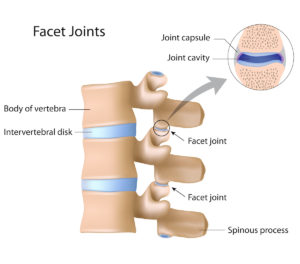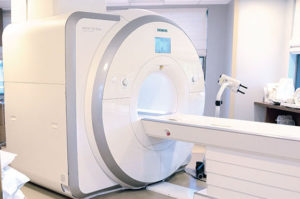 What are Facet Joints?
What are Facet Joints?
Facet joints are the small, angular joints on either side of the ring-shaped bone surrounding the vertebral bodies. Those joints are important in stabilizing spinal movement. The angle and height of facets and how they sit on the vertebral segment determine the range of motion allowed at the vertebrae.
That means that the degree of flexibility and the direction in which your spine can move varies for each region (i.e., neck, thoracic, upper back cervical, or middle back).
What is Facet Hypertrophy?
Facet hypertrophy is when these vertebral joints are widened. The vertebral joints widen as the cartilage on the joints wears out. Cartilage covers the bone surfaces on these vertebral joints which protects the bone from friction and distributes the pressure evenly along the bone. Cartilage wear can occur, for example, due to prolonged, excessive stress on the joints.
 Having worn-out vertebral joints can lead to back pain and restrict spinal movements. Nerves that run near the spinal joints can also get damaged or irritated in the process of vertebral joint wear and tear. Increased swelling of the facet joint can pressure the spinal nerves which causes pain and discomfort. When left untreated, facet hypertrophy may contribute to spinal stenosis and radiculopathy, among other conditions.
Having worn-out vertebral joints can lead to back pain and restrict spinal movements. Nerves that run near the spinal joints can also get damaged or irritated in the process of vertebral joint wear and tear. Increased swelling of the facet joint can pressure the spinal nerves which causes pain and discomfort. When left untreated, facet hypertrophy may contribute to spinal stenosis and radiculopathy, among other conditions.
Facet Hypertrophy Symptoms
Facet joint disease may affect people differently. Some may feel nothing but mild pain, while others may become unable to move. The degree or severity of the symptoms and pain experienced from facet hypertrophy vary greatly based on the degenerated joint site, the extent of the damage, and the level of pressure the expansions exert on the surrounding nerves.
Facet degeneration in the upper back will result in symptoms in the shoulders and neck, for instance, and headaches in some cases. Other signs to watch out for include:
- Back Pain
- A feeling of pain and difficulty when arching the back
- Instability of the spine
- Numbness and pain in the buttocks or down the leg
- Pain that increases in intensity with activity
Facet Hypertrophy Causes
Facet joint enlargement is caused by several factors, including natural wear and tear inside of the spine due to old age. Degenerative diseases, sports injuries, and lifestyle choices can also cause the condition. Here are more possible causes of facet hypertrophy:
- A traumatic injury (that occurs as the result of an accident in a car, sports, or fall)
- Physical inactivity or lack of exercise
- Obesity and overweight
- Spinal fractures
- Poor posture
- Repetitive twisting or bending
- A torn ligament
Comorbid conditions that affect the spine can also worsen facet hypertrophy and cause even greater pain. Disc degeneration, for instance, a breakdown of the cushioning discs between the spinal vertebrae, exerts excess pressure on facet joints. This speeds up the atrophy (degeneration) of the cartilage.
Additionally, spondylolisthesis, a condition in which a vertebrae slips out of position, can exacerbate the pressure on a compromised facet joint.
Bone spurs or osteophytes may also cause or worsen facet hypertrophy. Bone spurs result from bone-on-bone contact, and the friction signals the body to build up bone projections to attempt to heal the area.
Lumbar Facet Hypertrophy
The lumbar area of the spine, or the lower back, is a common spot for facet hypertrophy to occur. You may feel stiffness in your lower back when leaning backward with decreased mobility. When facet hypertrophy is affecting the lower back the pain and symptoms can radiate downwards to the buttock, hip and upper thigh area.
Diagnosing Hypertrophic Facet Disease
Figuring out the cause of pain symptoms is sometimes difficult since facet hypertrophy symptoms are similar to a herniated disc or spinal stenosis. With the assistance of imaging techniques and a medial branch block as a test, the source of pain can be confirmed. Medial branch blocks is a short term pain relief injection at the medial branch nerve of your spine. These nerves are associated with the facet joints, and if there is pain relief after a MBB then the source of pain can be pinpointed as the facet joints in the injected area.
Diagnostic Tests for Facet Hypertrophy
Part of the diagnosis of facet arthropathy is describing your symptoms at a physical exam. A set of imaging tests, such as X-rays or magnetic resonance imaging (MRI), can sometimes be used to detect degenerative changes in joints.
Computerized Tomography: The spine can be visualized with the use of a CT scan. A CT reveals more details than an X-ray and can show any damage to nerve systems or the spinal cord.
EMG/NCS: Electromyogram and nerve conduction studies may be used to analyze the nerve and muscle tissues’ electrical activity. This could provide information on nerve damage or sensory nerve compression, for instance.
MRI scan: Using magnetic fields and radiofrequency waves, magnetic resonance imaging (MRI) provides a detailed image of the spine that reveals discs, nerves, skin, and other structures that aren’t visible using an X-ray. Contrast agents are sometimes injected into tissues or structures to highlight details more clearly. MRIs can also reveal past injuries.
After the diagnosis is confirmed the person with facet hypertrophy is provided with an individualized treatment and care plan by our team of skilled specialists.
Facet Hypertrophy Treatment
Diagnosing a facet disease may be the first step your doctor performs, but treatment is the ultimate goal. Starting with non-invasive conservative treatments is standard, and if these processes don’t relieve symptoms then injections and possibly surgical procedures will be explored. Finding a doctor that specializes in diagnosing and treating facet hypertrophy is ideal, and usually neurosurgeons aree perfectly suited to deal with conditions caused by nerves such as facet disease.
Home Exercise and Physiotherapy for Facet Disease
Exercise at home and physiotherapy are essential components of treatment for facet disease. Strengthening the muscles and ligaments surrounding your spine and making them more flexible will help provide more support for your joints. Medication can help relieve pain. Some opiates like tramadol may help with acute pain treatment. There is also a procedure called a facet joint injection which administers a numbing medication as well as a time-release cortisone steroid to reduce inflammation and provide longer term pain relief.
Facet Hypertrophy Surgeries
Surgery is an option for treating facet hypertrophy and the associated symptoms like lower back pain. There are a few different avenues your doctor can discuss with you after the diagnosis is confirmed, and will walk you through the pros and cons of each procedure.
Endoscopic Spinal Decompression
During rehabilitation, over-the-counter pain medications such as ibuprofen or acetaminophen. Once we have reviewed your diagnosis and tried all conservative treatment options, spinal decompression may be recommended.
This procedure is performed through a tiny incision of about 1/2 inches. This is then followed by the insertion of a tiny camera called an endoscope that moves around muscles (not through). Following that, small surgical tools are used to eliminate the obstructive bone mass to widen passageways for the nerves to stop the pain. The procedure is also called a minimally-invasive laminectomy.
Minimally Invasive Spinal Fusion
Spinal fusion involves adding bone grafting or implants to keep the affected vertebrae from rubbing against each other. This stops nerve impingement and eliminates pain. This minimally-invasive procedure has many advantages; smaller incisions don’t cut muscles, less scarring, and accelerated recovery time.
Doctors Who Treat Facet Syndrome
Patients having back pain typically visit their primary care physician first. However, the moment you suspect facet hypertrophy, you should seek immediate consulting at a spine center. Early intervention can prevent it from worsening.
At the AllSpine Laser and Surgery Center, we have many experienced spine surgeons, pain management specialists, and nurses to provide you comprehensive care.
We often begin with non-surgical and non-invasive approaches. For patients that critically need surgery, we offer minimally invasive procedures in our state-of-the-art facilities. Our objectives are a faster recovery for you, less pain, and minimal downtime.


